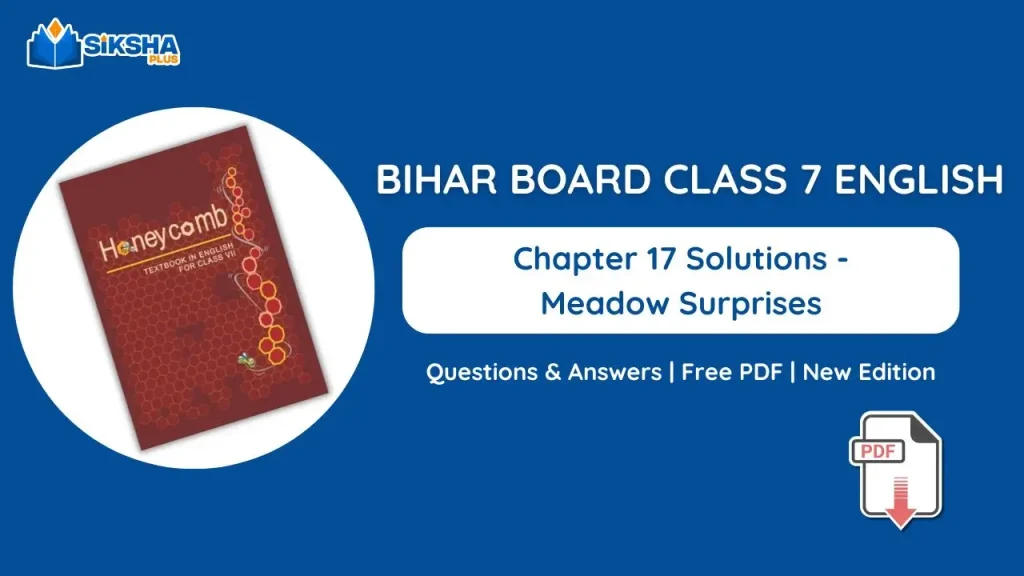Bihar Board Class 7 English Chapter 17 Solutions is available for free here. It covers all question answers of chapter 17 – “Meadow Surprises”, from new book – Honeycomb.
“Meadow Surprises” is a beautiful poem by Lois Brandt Phillips that takes us on a journey through a meadow to discover its hidden treasures. The poem shows how meadows are full of wonderful surprises like colorful butterflies, hidden bird nests, and tiny creatures that we might miss if we don’t look carefully. This chapter teaches students to slow down and observe nature with attention and curiosity. Below you can find the detailed solutions for Chapter 17 – Meadow Surprises from Bihar Board Class 7 English Book.

Bihar Board Class 7 English Chapter 17 Solutions
| Class | 7 |
| Subject | English (Honeycomb) |
| Chapter | 17. Meadow Surprises |
| Board | Bihar Board |
WORKING WITH THE POEM
1. Read the lines in which the following phrases occur. Then discuss with your partner the meaning of each phrase in its context.
(i) Velvet grass.
Ans: Velvet grass means the grass is very soft to touch, just like velvet cloth.
(ii) Drinking straws.
Ans: “Drinking straws” refers to how butterflies drink nectar from flowers using their long, thin tongues, which look like they’re using straws to sip from the flowers.
(iii) Meadow houses.
Ans: Meadow houses are the homes of small animals living in the meadow, such as rabbit burrows, bird nests, and anthills where ants live.
(iv) Amazing mound.
Ans: An “amazing mound” is a small hill-like structure made by animals as their home. Examples include ant mounds (anthills) that ants build above the ground.
(v) Fuzzy head.
Ans: The “fuzzy head” refers to the soft, fluffy top of a dandelion after it has finished flowering. These fuzzy heads break apart and float away when blown.
2. Which line in the poem suggests that you need a keen eye and a sharp ear to enjoy a meadow? Read aloud the stanza that contains this line.
Ans: The line that suggests we need a keen eye and sharp ear to enjoy a meadow is “If you look and listen well.” This line is from the following stanza:
“Oh! Meadows have surprises
And many things to tell;
You may discover these yourself,
If you look and listen well.”
3. Find pictures of the kinds of birds, insects and scenes mentioned in the poem.
Ans: Students please do yourself. You can take help from your class teacher.
4. Watch a tree or a plant, or walk across a field or park at the same time everyday for a week. Keep a diary of what you see and hear. At the end of the week, write a short paragraph or a poem about your experiences. Put your writing up on the class bulletin board.
Ans: Sample Diary Entry:
My Week with Nature
- Day 1: I sat under the neem tree in our school garden. I saw two sparrows building a nest. Their chirping sounded happy.
- Day 2: Today I noticed tiny ants carrying food to their anthill. They worked together so well!
- Day 3: After yesterday’s rain, I found small mushrooms growing near the tree. The grass looked greener too.
- Day 4: A butterfly with orange and black wings visited the yellow flowers. It stayed for a long time, drinking nectar.
- Day 5: The sparrows’ nest looks almost complete now. I heard a squirrel making noises from a branch above.
- Day 6: Today was windy. I watched leaves dancing in the air before falling gently to the ground.
- Day 7: I saw a rainbow after the light shower. The birds seemed to sing louder and happier today.
My week with nature taught me that there’s always something new to discover if we take time to look and listen carefully. The garden is full of life and small wonders that change every day.
